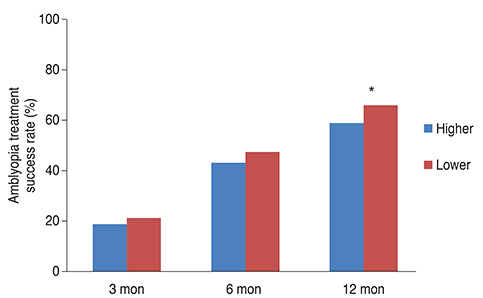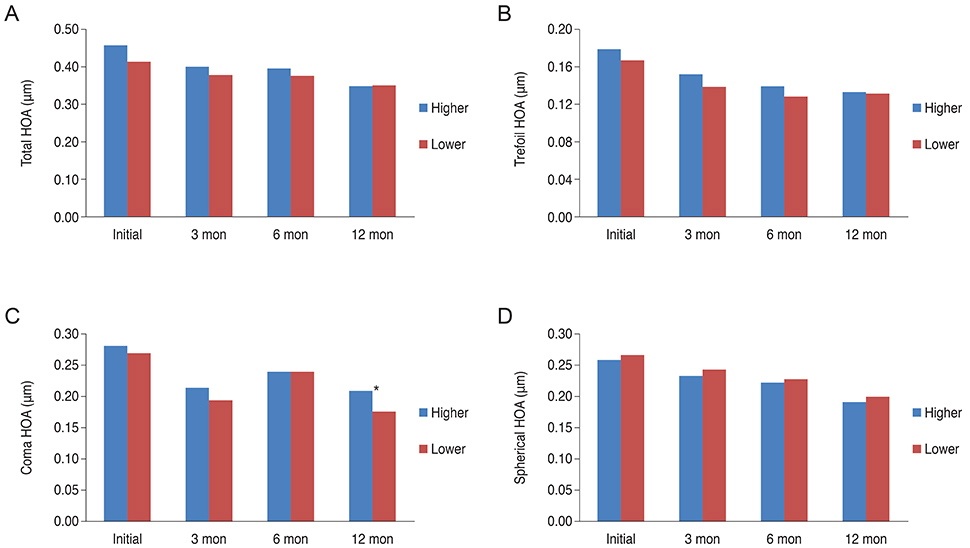Korean J Ophthalmol.
2016 Feb;30(1):53-59. 10.3341/kjo.2016.30.1.53.
Higher Order Aberration and Astigmatism in Children with Hyperopic Amblyopia
- Affiliations
-
- 1Department of Ophthalmology, Inje University Ilsan Paik Hospital, Inje University College of Medicine, Goyang, Korea. jiwoong_chang@paik.ac.kr
- KMID: 2363891
- DOI: http://doi.org/10.3341/kjo.2016.30.1.53
Abstract
- PURPOSE
To investigate the changes in corneal higher-order aberration (HOA) during amblyopia treatment and the correlation between HOA and astigmatism in hyperopic amblyopia children.
METHODS
In this retrospective study, a total of 72 eyes from 72 patients ranging in age from 38 to 161 months were included. Patients were divided into two groups based on the degree of astigmatism. Corneal HOA was measured using a KR-1W aberrometer at the initial visit and at 3-, 6-, and 12-month follow-ups. Correlation analysis was performed to assess the association between HOA and astigmatism.
RESULTS
A total of 72 patients were enrolled in this study, 37 of which were classified as belonging to the higher astigmatism group, while 35 were assigned to the lower astigmatism group. There was a statistically significant difference in success rate between the higher and lower astigmatism groups. In both groups, all corneal HOAs were significantly reduced during amblyopia treatment. When comparing the two groups, a significant difference in coma HOA at the 12-month follow-up was detected (p = 0.043). In the Pearson correlation test, coma HOA at the 12-month follow-up demonstrated a statistically significant correlation with astigmatism and a stronger correlation with astigmatism in the higher astigmatism group than in the lower astigmatism group (coefficient values, 0.383 and 0.284 as well as p = 0.021 and p = 0.038, respectively).
CONCLUSIONS
HOA, particularly coma HOA, correlated with astigmatism and could exert effects in cases involving hyperopic amblyopia.
MeSH Terms
Figure
Reference
-
1. von Noorden GK, Campos EC, editors. Binocular vision and ocular motility: theory and management of strabismus. 6th ed. St. Louis: Mosby;2002. p. 246–251.2. Flom MC, Bedell HE. Identifying amblyopia using associated conditions, acuity, and nonacuity features. Am J Optom Physiol Opt. 1985; 62:153–160.3. Pediatric Eye Disease Investigator Group. The clinical profile of moderate amblyopia in children younger than 7 years. Arch Ophthalmol. 2002; 120:281–287.4. Woodruff G, Hiscox F, Thompson JR, Smith LK. Factors affecting the outcome of children treated for amblyopia. Eye (Lond). 1994; 8(Pt 6):627–631.5. Yoon GY, Williams DR. Visual performance after correcting the monochromatic and chromatic aberrations of the eye. J Opt Soc Am A Opt Image Sci Vis. 2002; 19:266–275.6. Williams D, Yoon GY, Porter J, et al. Visual benefit of correcting higher order aberrations of the eye. J Refract Surg. 2000; 16:S554–S559.7. Prakash G, Sharma N, Saxena R, et al. Comparison of higher order aberration profiles between normal and amblyopic eyes in children with idiopathic amblyopia. Acta Ophthalmol. 2011; 89:e257–e262.8. Lee SH, Chang JW. The relationship between higher-order aberrations and amblyopia treatment in hyperopic anisometropic amblyopia. Korean J Ophthalmol. 2014; 28:66–75.9. Liang J, Grimm B, Goelz S, Bille JF. Objective measurement of wave aberrations of the human eye with the use of a Hartmann-Shack wave-front sensor. J Opt Soc Am A Opt Image Sci Vis. 1994; 11:1949–1957.10. Levy Y, Segal O, Avni I, Zadok D. Ocular higher-order aberrations in eyes with supernormal vision. Am J Ophthalmol. 2005; 139:225–228.11. Dominguez-Vicent A, Perez-Vives C, Ferrer-Blasco T, et al. The effect of simulated normal and amblyopic higher-order aberrations on visual performance. J AAPOS. 2013; 17:269–275.12. Zhao PF, Zhou YH, Wang NL, Zhang J. Study of the wavefront aberrations in children with amblyopia. Chin Med J (Engl). 2010; 123:1431–1435.13. Ziylan S, Yabas O, Zorlutuna N, Serin D. Isoametropic amblyopia in highly hyperopic children. Acta Ophthalmol Scand. 2007; 85:111–113.14. Rossi EA, Weiser P, Tarrant J, Roorda A. Visual performance in emmetropia and low myopia after correction of high-order aberrations. J Vis. 2007; 7:14.15. Karimian F, Feizi S, Doozande A. Higher-order aberrations in myopic eyes. J Ophthalmic Vis Res. 2010; 5:3–9.16. Oshika T, Klyce SD, Applegate RA, Howland HC. Changes in corneal wavefront aberrations with aging. Invest Ophthalmol Vis Sci. 1999; 40:1351–1355.17. Wang L, Dai E, Koch DD, Nathoo A. Optical aberrations of the human anterior cornea. J Cataract Refract Surg. 2003; 29:1514–1521.18. Fujikado T, Kuroda T, Ninomiya S, et al. Age-related changes in ocular and corneal aberrations. Am J Ophthalmol. 2004; 138:143–146.19. Brunette I, Bueno JM, Parent M, et al. Monochromatic aberrations as a function of age, from childhood to advanced age. Invest Ophthalmol Vis Sci. 2003; 44:5438–5446.20. Wu C, Hunter DG. Amblyopia: diagnostic and therapeutic options. Am J Ophthalmol. 2006; 141:175–184.21. Kwan WC, Yip SP, Yap MK. Monochromatic aberrations of the human eye and myopia. Clin Exp Optom. 2009; 92:304–312.22. Wei RH, Lim L, Chan WK, Tan DT. Higher order ocular aberrations in eyes with myopia in a Chinese population. J Refract Surg. 2006; 22:695–702.23. Plech AR, Pinero DP, Laria C, et al. Corneal higher-order aberrations in amblyopia. Eur J Ophthalmol. 2010; 20:12–20.
- Full Text Links
- Actions
-
Cited
- CITED
-
- Close
- Share
- Similar articles
-
- Clinical Study on Refractive Amblyopia
- Results of Treatment in Childhood with High Hyperopic or Astigmatic Amblyopia
- The Relationship between Higher-order Aberrations and Amblyopia Treatment in Hyperopic Anisometropic Amblyopia
- Long-term Follow-up Results of Hyperopic Refractive Change
- Long-Term Changes of Hyperopic Refractive Error in Refractive Accommodative Esotropia



